Comprehensive Report on Investment Portfolio Theory & Management
VerifiedAdded on 2023/06/11
|12
|2467
|244
Report
AI Summary
This report provides a detailed overview of portfolio theory and investment management. It addresses key concepts such as risk premium, efficient market hypothesis, and portfolio performance evaluation. The report includes an explanation of the portfolio management process, characteristics of a good market, and the uses of security market indexes. It also covers industry analysis, the business cycle's impact on industry sectors, and strategic analysis tools like SWOT and Porter's Five Forces. The conclusion emphasizes the importance of constructing an efficient portfolio to minimize risk and maximize returns, highlighting the need for a thorough understanding of portfolio aspects and market conditions.
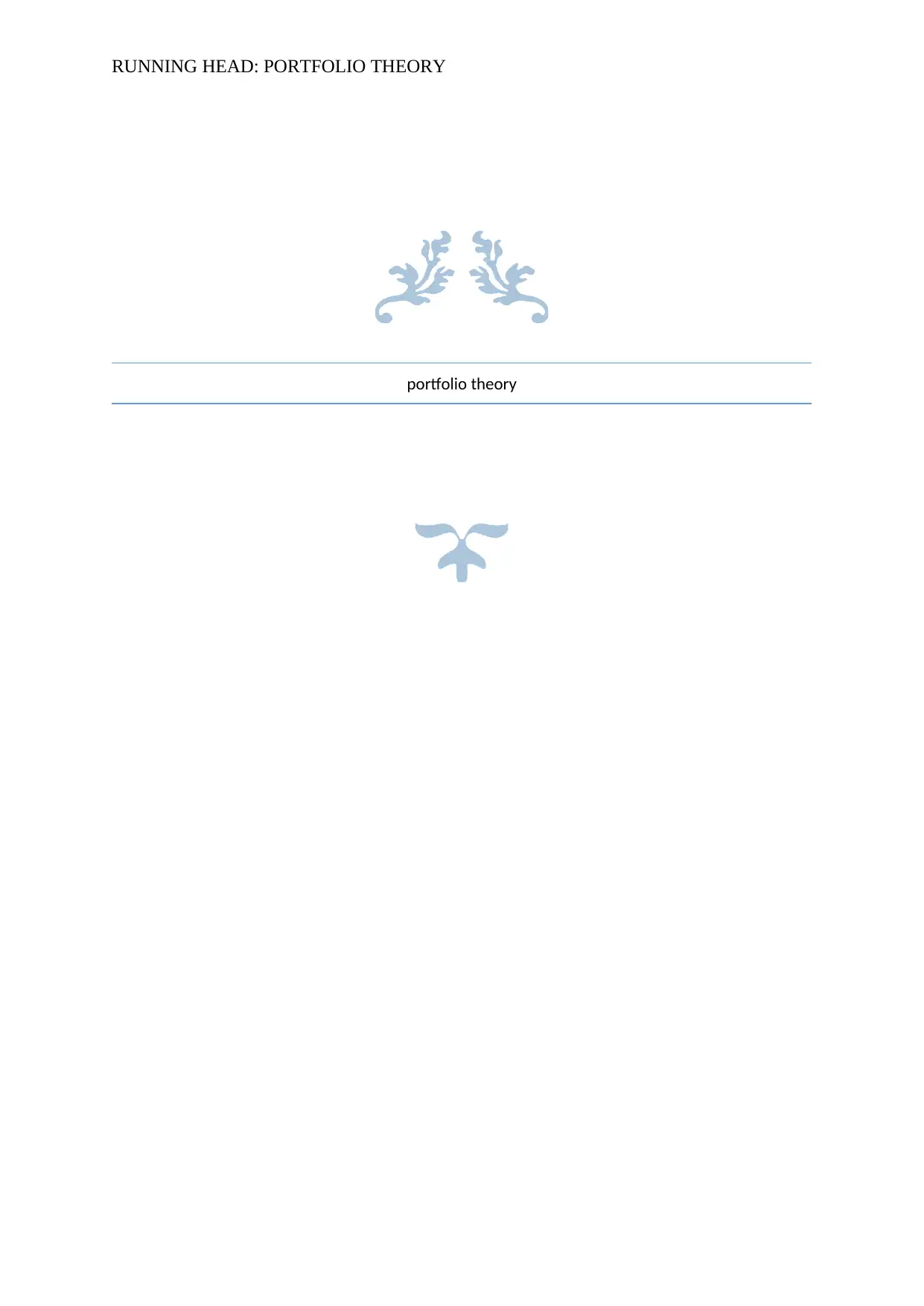
RUNNING HEAD: PORTFOLIO THEORY
portfolio theory
portfolio theory
Paraphrase This Document
Need a fresh take? Get an instant paraphrase of this document with our AI Paraphraser
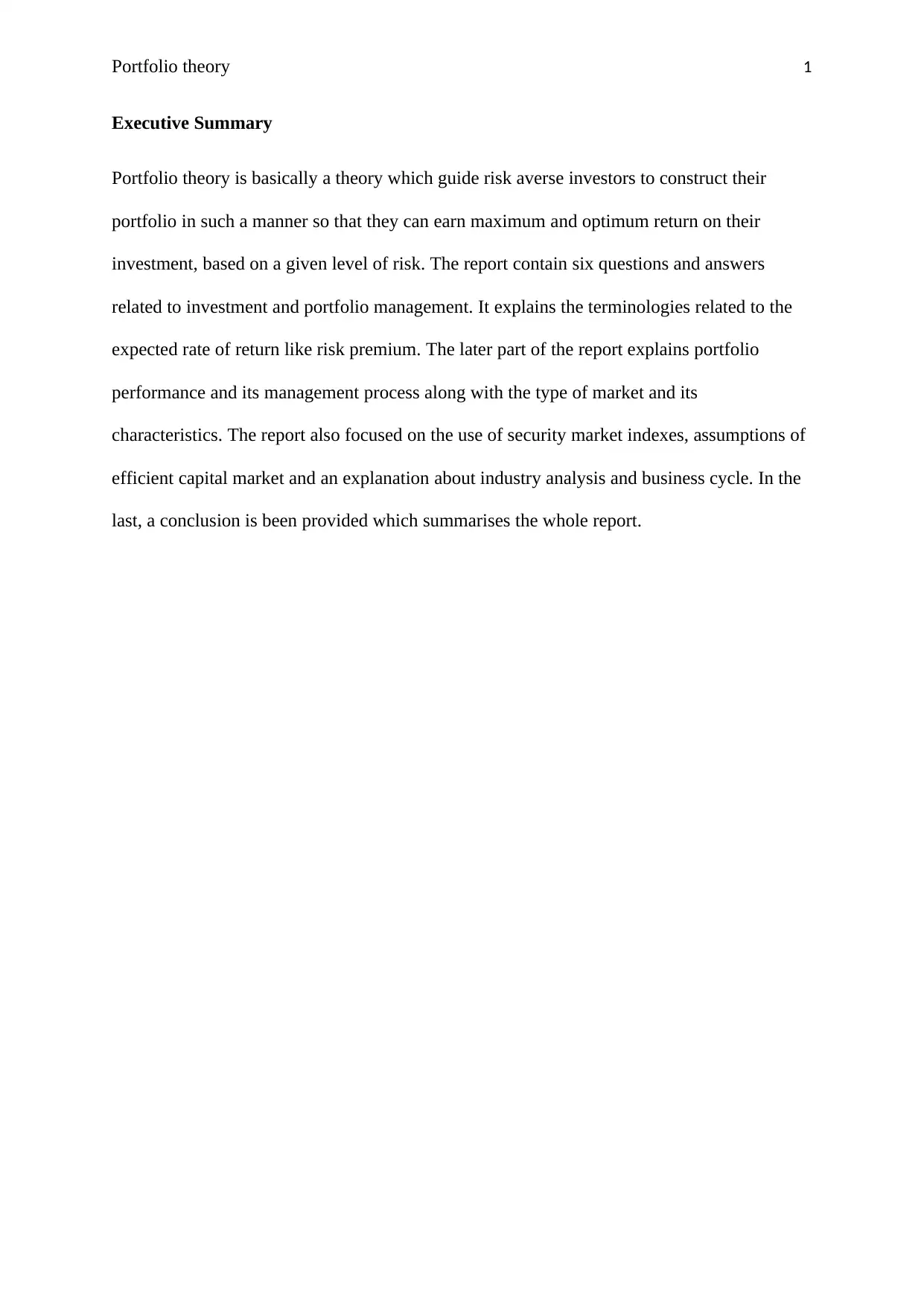
Portfolio theory 1
Executive Summary
Portfolio theory is basically a theory which guide risk averse investors to construct their
portfolio in such a manner so that they can earn maximum and optimum return on their
investment, based on a given level of risk. The report contain six questions and answers
related to investment and portfolio management. It explains the terminologies related to the
expected rate of return like risk premium. The later part of the report explains portfolio
performance and its management process along with the type of market and its
characteristics. The report also focused on the use of security market indexes, assumptions of
efficient capital market and an explanation about industry analysis and business cycle. In the
last, a conclusion is been provided which summarises the whole report.
Executive Summary
Portfolio theory is basically a theory which guide risk averse investors to construct their
portfolio in such a manner so that they can earn maximum and optimum return on their
investment, based on a given level of risk. The report contain six questions and answers
related to investment and portfolio management. It explains the terminologies related to the
expected rate of return like risk premium. The later part of the report explains portfolio
performance and its management process along with the type of market and its
characteristics. The report also focused on the use of security market indexes, assumptions of
efficient capital market and an explanation about industry analysis and business cycle. In the
last, a conclusion is been provided which summarises the whole report.
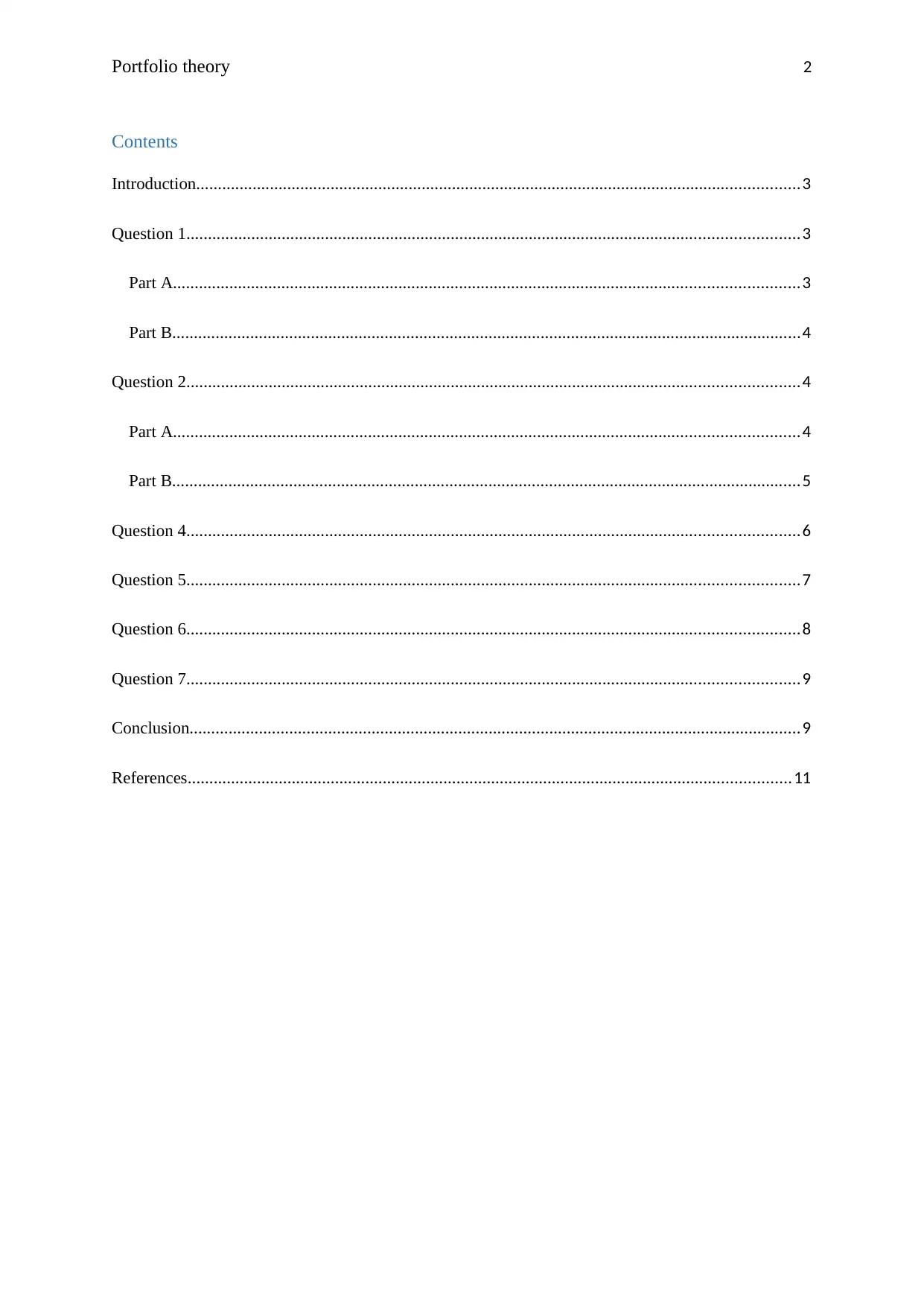
Portfolio theory 2
Contents
Introduction...........................................................................................................................................3
Question 1.............................................................................................................................................3
Part A................................................................................................................................................3
Part B.................................................................................................................................................4
Question 2.............................................................................................................................................4
Part A................................................................................................................................................4
Part B.................................................................................................................................................5
Question 4.............................................................................................................................................6
Question 5.............................................................................................................................................7
Question 6.............................................................................................................................................8
Question 7.............................................................................................................................................9
Conclusion.............................................................................................................................................9
References...........................................................................................................................................11
Contents
Introduction...........................................................................................................................................3
Question 1.............................................................................................................................................3
Part A................................................................................................................................................3
Part B.................................................................................................................................................4
Question 2.............................................................................................................................................4
Part A................................................................................................................................................4
Part B.................................................................................................................................................5
Question 4.............................................................................................................................................6
Question 5.............................................................................................................................................7
Question 6.............................................................................................................................................8
Question 7.............................................................................................................................................9
Conclusion.............................................................................................................................................9
References...........................................................................................................................................11
⊘ This is a preview!⊘
Do you want full access?
Subscribe today to unlock all pages.

Trusted by 1+ million students worldwide
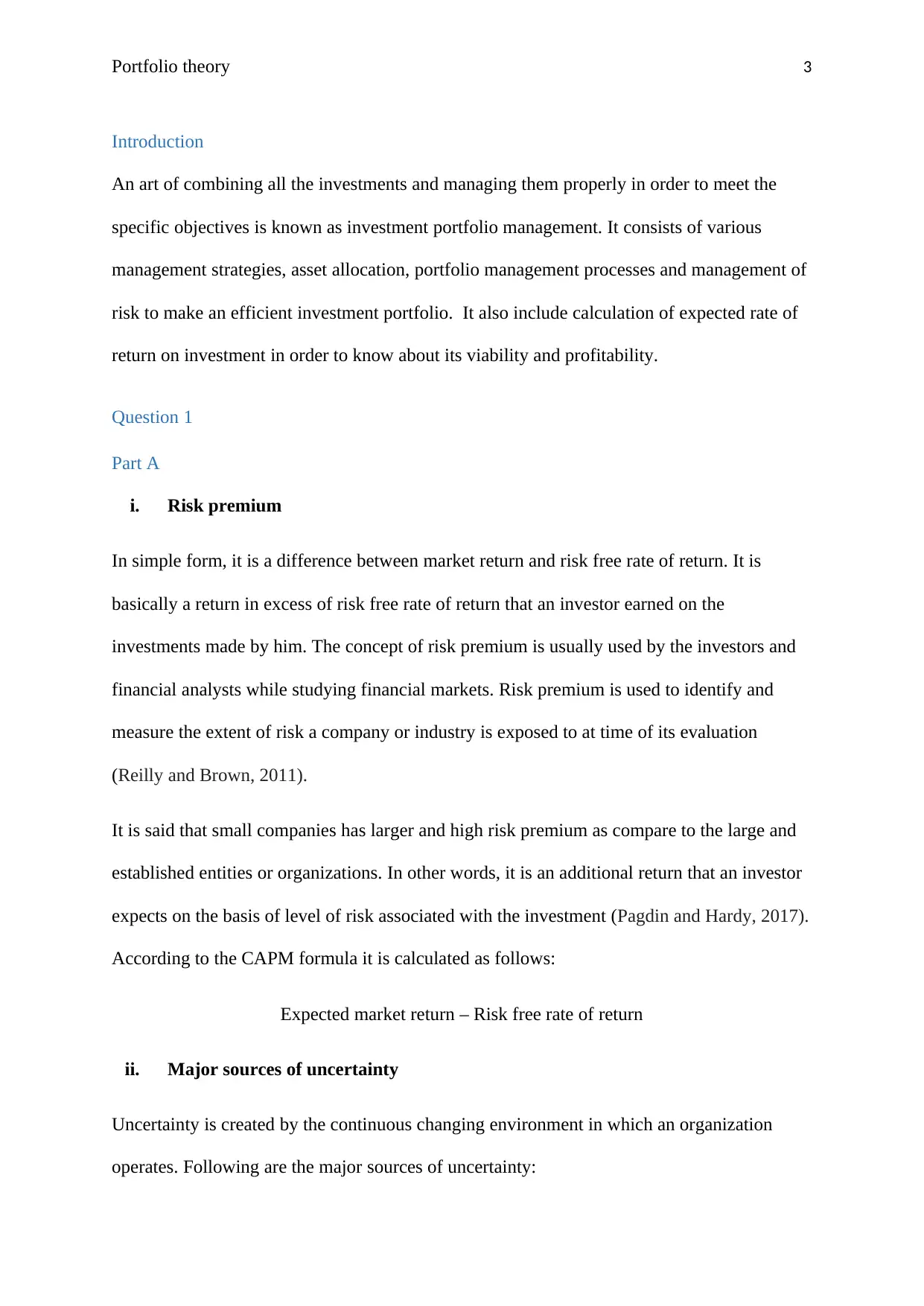
Portfolio theory 3
Introduction
An art of combining all the investments and managing them properly in order to meet the
specific objectives is known as investment portfolio management. It consists of various
management strategies, asset allocation, portfolio management processes and management of
risk to make an efficient investment portfolio. It also include calculation of expected rate of
return on investment in order to know about its viability and profitability.
Question 1
Part A
i. Risk premium
In simple form, it is a difference between market return and risk free rate of return. It is
basically a return in excess of risk free rate of return that an investor earned on the
investments made by him. The concept of risk premium is usually used by the investors and
financial analysts while studying financial markets. Risk premium is used to identify and
measure the extent of risk a company or industry is exposed to at time of its evaluation
(Reilly and Brown, 2011).
It is said that small companies has larger and high risk premium as compare to the large and
established entities or organizations. In other words, it is an additional return that an investor
expects on the basis of level of risk associated with the investment (Pagdin and Hardy, 2017).
According to the CAPM formula it is calculated as follows:
Expected market return – Risk free rate of return
ii. Major sources of uncertainty
Uncertainty is created by the continuous changing environment in which an organization
operates. Following are the major sources of uncertainty:
Introduction
An art of combining all the investments and managing them properly in order to meet the
specific objectives is known as investment portfolio management. It consists of various
management strategies, asset allocation, portfolio management processes and management of
risk to make an efficient investment portfolio. It also include calculation of expected rate of
return on investment in order to know about its viability and profitability.
Question 1
Part A
i. Risk premium
In simple form, it is a difference between market return and risk free rate of return. It is
basically a return in excess of risk free rate of return that an investor earned on the
investments made by him. The concept of risk premium is usually used by the investors and
financial analysts while studying financial markets. Risk premium is used to identify and
measure the extent of risk a company or industry is exposed to at time of its evaluation
(Reilly and Brown, 2011).
It is said that small companies has larger and high risk premium as compare to the large and
established entities or organizations. In other words, it is an additional return that an investor
expects on the basis of level of risk associated with the investment (Pagdin and Hardy, 2017).
According to the CAPM formula it is calculated as follows:
Expected market return – Risk free rate of return
ii. Major sources of uncertainty
Uncertainty is created by the continuous changing environment in which an organization
operates. Following are the major sources of uncertainty:
Paraphrase This Document
Need a fresh take? Get an instant paraphrase of this document with our AI Paraphraser
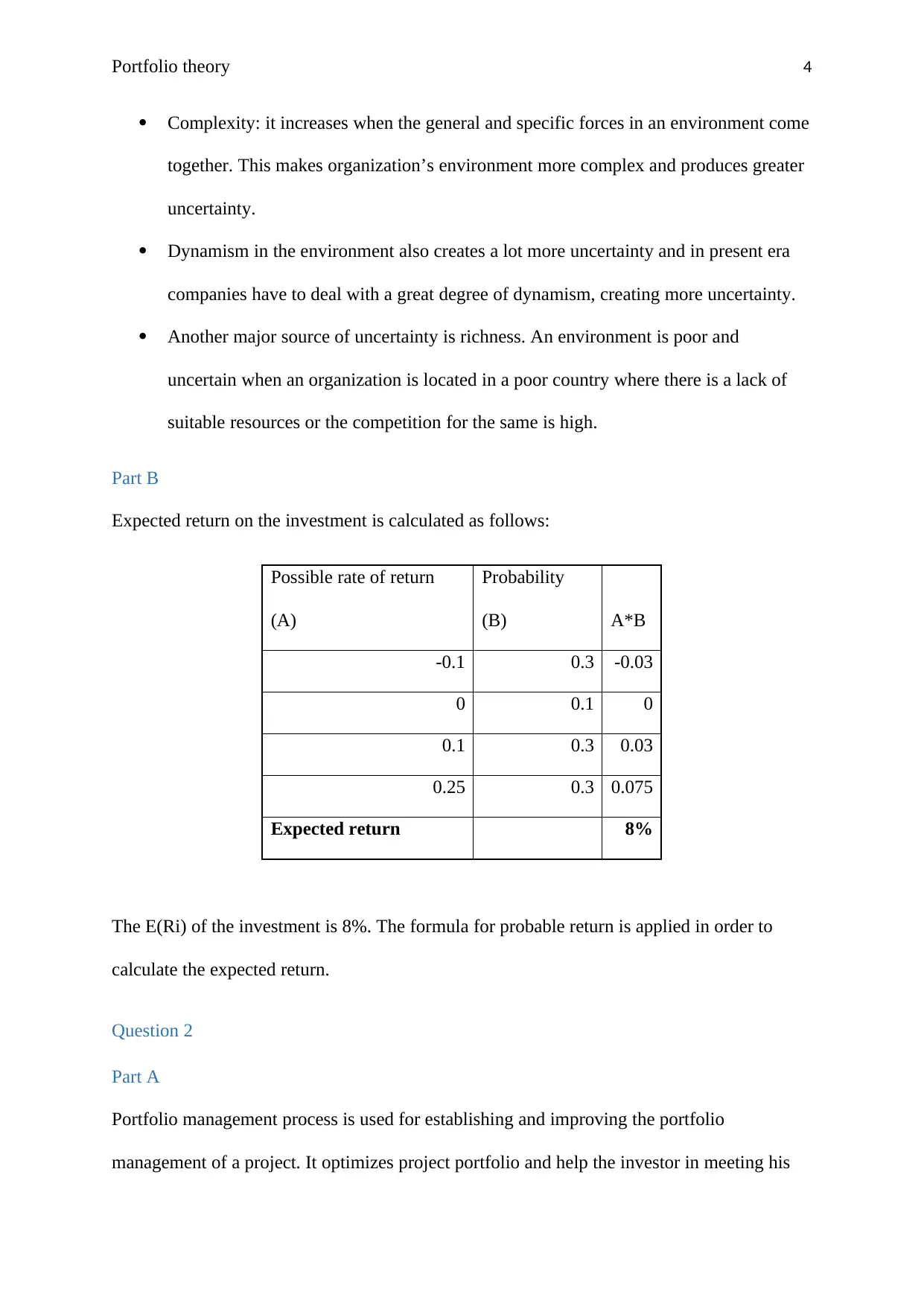
Portfolio theory 4
Complexity: it increases when the general and specific forces in an environment come
together. This makes organization’s environment more complex and produces greater
uncertainty.
Dynamism in the environment also creates a lot more uncertainty and in present era
companies have to deal with a great degree of dynamism, creating more uncertainty.
Another major source of uncertainty is richness. An environment is poor and
uncertain when an organization is located in a poor country where there is a lack of
suitable resources or the competition for the same is high.
Part B
Expected return on the investment is calculated as follows:
Possible rate of return
(A)
Probability
(B) A*B
-0.1 0.3 -0.03
0 0.1 0
0.1 0.3 0.03
0.25 0.3 0.075
Expected return 8%
The E(Ri) of the investment is 8%. The formula for probable return is applied in order to
calculate the expected return.
Question 2
Part A
Portfolio management process is used for establishing and improving the portfolio
management of a project. It optimizes project portfolio and help the investor in meeting his
Complexity: it increases when the general and specific forces in an environment come
together. This makes organization’s environment more complex and produces greater
uncertainty.
Dynamism in the environment also creates a lot more uncertainty and in present era
companies have to deal with a great degree of dynamism, creating more uncertainty.
Another major source of uncertainty is richness. An environment is poor and
uncertain when an organization is located in a poor country where there is a lack of
suitable resources or the competition for the same is high.
Part B
Expected return on the investment is calculated as follows:
Possible rate of return
(A)
Probability
(B) A*B
-0.1 0.3 -0.03
0 0.1 0
0.1 0.3 0.03
0.25 0.3 0.075
Expected return 8%
The E(Ri) of the investment is 8%. The formula for probable return is applied in order to
calculate the expected return.
Question 2
Part A
Portfolio management process is used for establishing and improving the portfolio
management of a project. It optimizes project portfolio and help the investor in meeting his
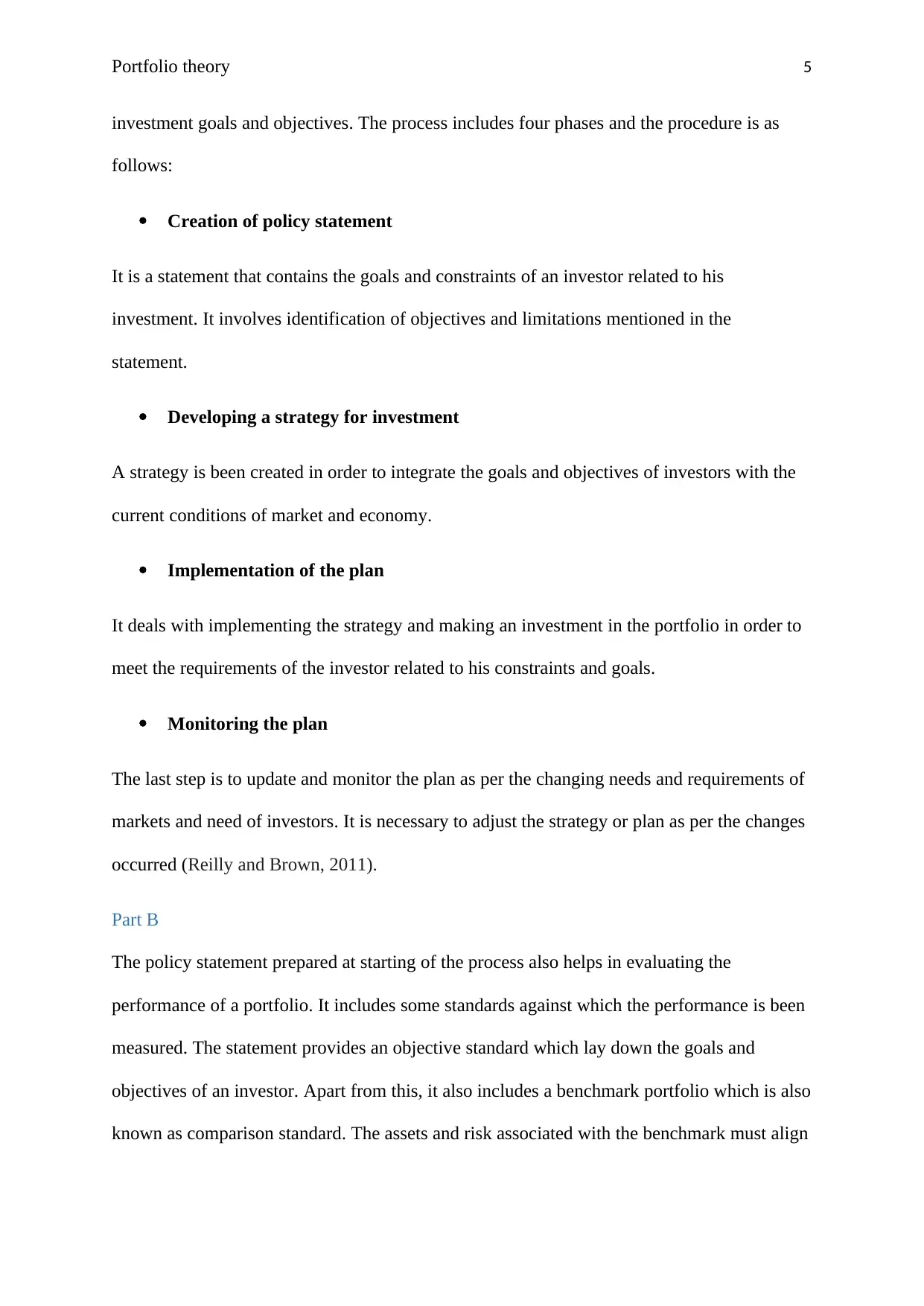
Portfolio theory 5
investment goals and objectives. The process includes four phases and the procedure is as
follows:
Creation of policy statement
It is a statement that contains the goals and constraints of an investor related to his
investment. It involves identification of objectives and limitations mentioned in the
statement.
Developing a strategy for investment
A strategy is been created in order to integrate the goals and objectives of investors with the
current conditions of market and economy.
Implementation of the plan
It deals with implementing the strategy and making an investment in the portfolio in order to
meet the requirements of the investor related to his constraints and goals.
Monitoring the plan
The last step is to update and monitor the plan as per the changing needs and requirements of
markets and need of investors. It is necessary to adjust the strategy or plan as per the changes
occurred (Reilly and Brown, 2011).
Part B
The policy statement prepared at starting of the process also helps in evaluating the
performance of a portfolio. It includes some standards against which the performance is been
measured. The statement provides an objective standard which lay down the goals and
objectives of an investor. Apart from this, it also includes a benchmark portfolio which is also
known as comparison standard. The assets and risk associated with the benchmark must align
investment goals and objectives. The process includes four phases and the procedure is as
follows:
Creation of policy statement
It is a statement that contains the goals and constraints of an investor related to his
investment. It involves identification of objectives and limitations mentioned in the
statement.
Developing a strategy for investment
A strategy is been created in order to integrate the goals and objectives of investors with the
current conditions of market and economy.
Implementation of the plan
It deals with implementing the strategy and making an investment in the portfolio in order to
meet the requirements of the investor related to his constraints and goals.
Monitoring the plan
The last step is to update and monitor the plan as per the changing needs and requirements of
markets and need of investors. It is necessary to adjust the strategy or plan as per the changes
occurred (Reilly and Brown, 2011).
Part B
The policy statement prepared at starting of the process also helps in evaluating the
performance of a portfolio. It includes some standards against which the performance is been
measured. The statement provides an objective standard which lay down the goals and
objectives of an investor. Apart from this, it also includes a benchmark portfolio which is also
known as comparison standard. The assets and risk associated with the benchmark must align
⊘ This is a preview!⊘
Do you want full access?
Subscribe today to unlock all pages.

Trusted by 1+ million students worldwide
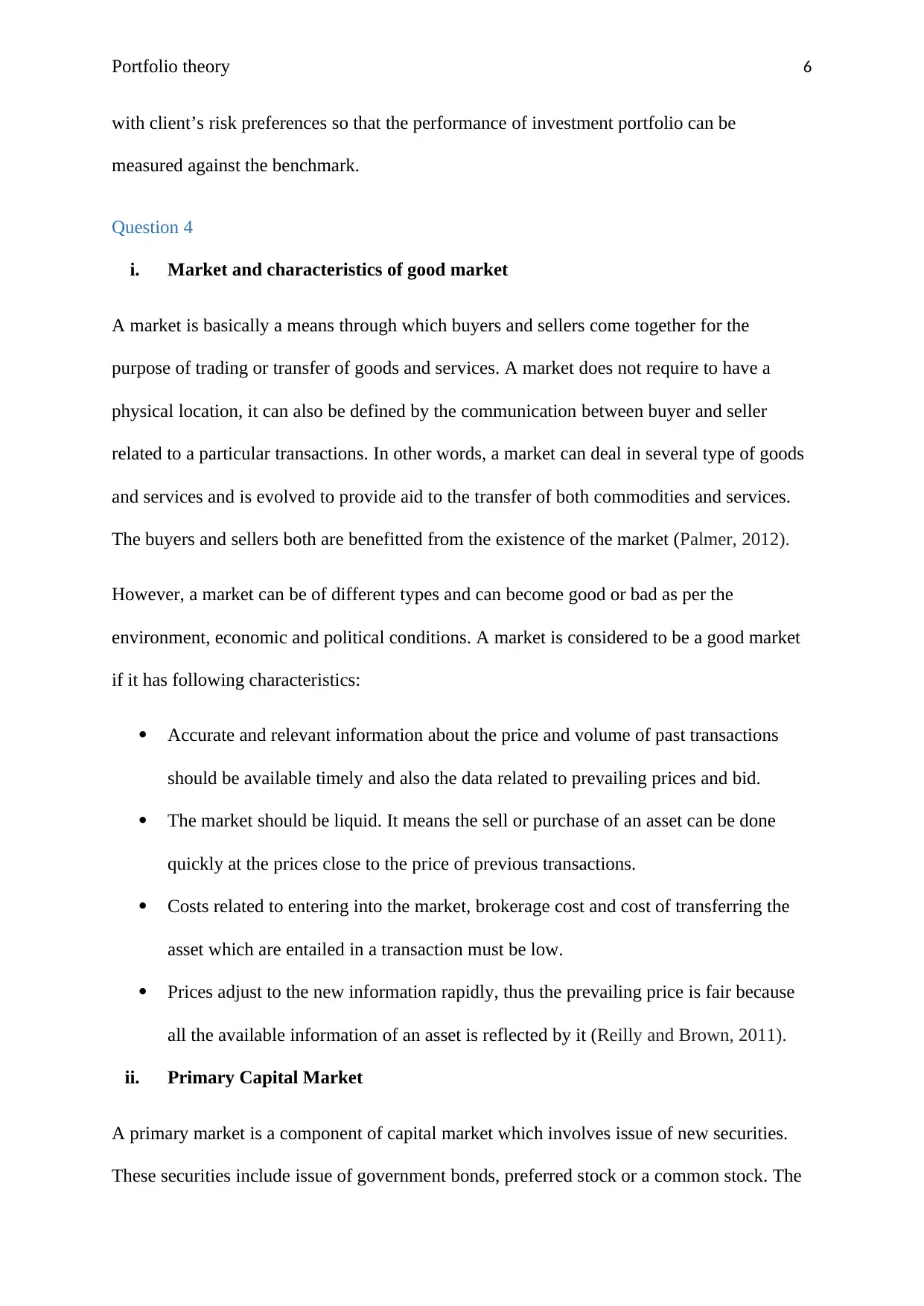
Portfolio theory 6
with client’s risk preferences so that the performance of investment portfolio can be
measured against the benchmark.
Question 4
i. Market and characteristics of good market
A market is basically a means through which buyers and sellers come together for the
purpose of trading or transfer of goods and services. A market does not require to have a
physical location, it can also be defined by the communication between buyer and seller
related to a particular transactions. In other words, a market can deal in several type of goods
and services and is evolved to provide aid to the transfer of both commodities and services.
The buyers and sellers both are benefitted from the existence of the market (Palmer, 2012).
However, a market can be of different types and can become good or bad as per the
environment, economic and political conditions. A market is considered to be a good market
if it has following characteristics:
Accurate and relevant information about the price and volume of past transactions
should be available timely and also the data related to prevailing prices and bid.
The market should be liquid. It means the sell or purchase of an asset can be done
quickly at the prices close to the price of previous transactions.
Costs related to entering into the market, brokerage cost and cost of transferring the
asset which are entailed in a transaction must be low.
Prices adjust to the new information rapidly, thus the prevailing price is fair because
all the available information of an asset is reflected by it (Reilly and Brown, 2011).
ii. Primary Capital Market
A primary market is a component of capital market which involves issue of new securities.
These securities include issue of government bonds, preferred stock or a common stock. The
with client’s risk preferences so that the performance of investment portfolio can be
measured against the benchmark.
Question 4
i. Market and characteristics of good market
A market is basically a means through which buyers and sellers come together for the
purpose of trading or transfer of goods and services. A market does not require to have a
physical location, it can also be defined by the communication between buyer and seller
related to a particular transactions. In other words, a market can deal in several type of goods
and services and is evolved to provide aid to the transfer of both commodities and services.
The buyers and sellers both are benefitted from the existence of the market (Palmer, 2012).
However, a market can be of different types and can become good or bad as per the
environment, economic and political conditions. A market is considered to be a good market
if it has following characteristics:
Accurate and relevant information about the price and volume of past transactions
should be available timely and also the data related to prevailing prices and bid.
The market should be liquid. It means the sell or purchase of an asset can be done
quickly at the prices close to the price of previous transactions.
Costs related to entering into the market, brokerage cost and cost of transferring the
asset which are entailed in a transaction must be low.
Prices adjust to the new information rapidly, thus the prevailing price is fair because
all the available information of an asset is reflected by it (Reilly and Brown, 2011).
ii. Primary Capital Market
A primary market is a component of capital market which involves issue of new securities.
These securities include issue of government bonds, preferred stock or a common stock. The
Paraphrase This Document
Need a fresh take? Get an instant paraphrase of this document with our AI Paraphraser
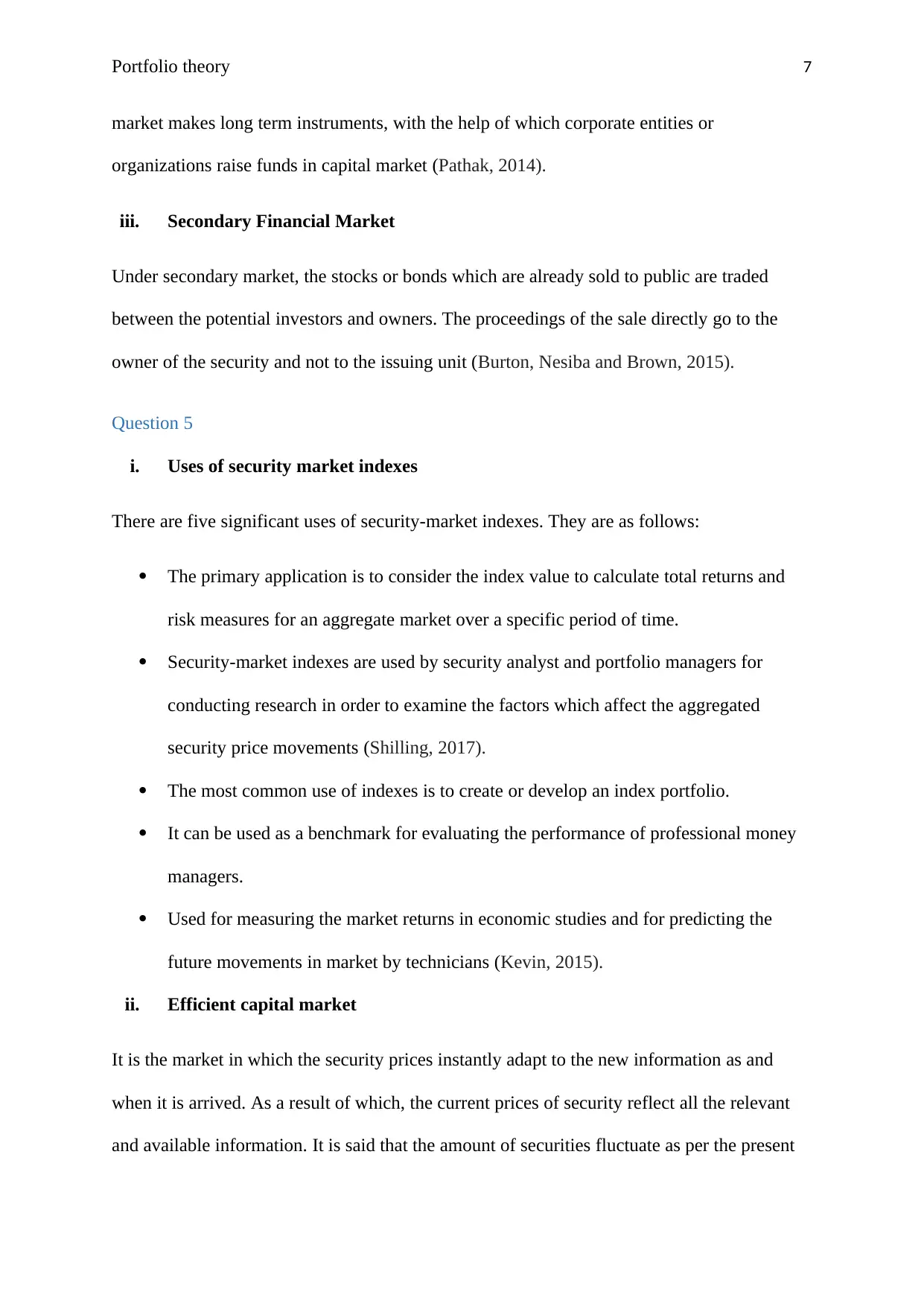
Portfolio theory 7
market makes long term instruments, with the help of which corporate entities or
organizations raise funds in capital market (Pathak, 2014).
iii. Secondary Financial Market
Under secondary market, the stocks or bonds which are already sold to public are traded
between the potential investors and owners. The proceedings of the sale directly go to the
owner of the security and not to the issuing unit (Burton, Nesiba and Brown, 2015).
Question 5
i. Uses of security market indexes
There are five significant uses of security-market indexes. They are as follows:
The primary application is to consider the index value to calculate total returns and
risk measures for an aggregate market over a specific period of time.
Security-market indexes are used by security analyst and portfolio managers for
conducting research in order to examine the factors which affect the aggregated
security price movements (Shilling, 2017).
The most common use of indexes is to create or develop an index portfolio.
It can be used as a benchmark for evaluating the performance of professional money
managers.
Used for measuring the market returns in economic studies and for predicting the
future movements in market by technicians (Kevin, 2015).
ii. Efficient capital market
It is the market in which the security prices instantly adapt to the new information as and
when it is arrived. As a result of which, the current prices of security reflect all the relevant
and available information. It is said that the amount of securities fluctuate as per the present
market makes long term instruments, with the help of which corporate entities or
organizations raise funds in capital market (Pathak, 2014).
iii. Secondary Financial Market
Under secondary market, the stocks or bonds which are already sold to public are traded
between the potential investors and owners. The proceedings of the sale directly go to the
owner of the security and not to the issuing unit (Burton, Nesiba and Brown, 2015).
Question 5
i. Uses of security market indexes
There are five significant uses of security-market indexes. They are as follows:
The primary application is to consider the index value to calculate total returns and
risk measures for an aggregate market over a specific period of time.
Security-market indexes are used by security analyst and portfolio managers for
conducting research in order to examine the factors which affect the aggregated
security price movements (Shilling, 2017).
The most common use of indexes is to create or develop an index portfolio.
It can be used as a benchmark for evaluating the performance of professional money
managers.
Used for measuring the market returns in economic studies and for predicting the
future movements in market by technicians (Kevin, 2015).
ii. Efficient capital market
It is the market in which the security prices instantly adapt to the new information as and
when it is arrived. As a result of which, the current prices of security reflect all the relevant
and available information. It is said that the amount of securities fluctuate as per the present
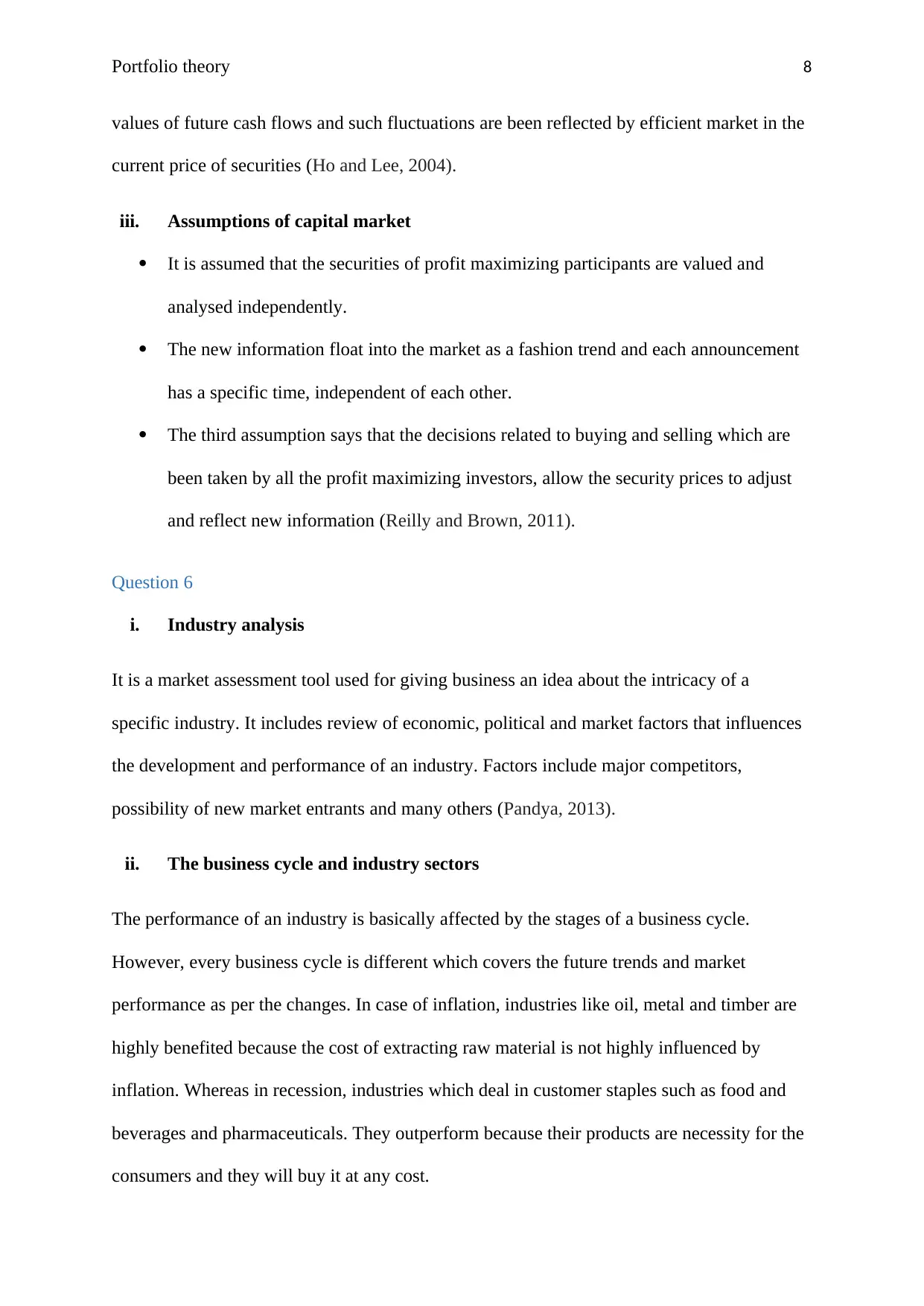
Portfolio theory 8
values of future cash flows and such fluctuations are been reflected by efficient market in the
current price of securities (Ho and Lee, 2004).
iii. Assumptions of capital market
It is assumed that the securities of profit maximizing participants are valued and
analysed independently.
The new information float into the market as a fashion trend and each announcement
has a specific time, independent of each other.
The third assumption says that the decisions related to buying and selling which are
been taken by all the profit maximizing investors, allow the security prices to adjust
and reflect new information (Reilly and Brown, 2011).
Question 6
i. Industry analysis
It is a market assessment tool used for giving business an idea about the intricacy of a
specific industry. It includes review of economic, political and market factors that influences
the development and performance of an industry. Factors include major competitors,
possibility of new market entrants and many others (Pandya, 2013).
ii. The business cycle and industry sectors
The performance of an industry is basically affected by the stages of a business cycle.
However, every business cycle is different which covers the future trends and market
performance as per the changes. In case of inflation, industries like oil, metal and timber are
highly benefited because the cost of extracting raw material is not highly influenced by
inflation. Whereas in recession, industries which deal in customer staples such as food and
beverages and pharmaceuticals. They outperform because their products are necessity for the
consumers and they will buy it at any cost.
values of future cash flows and such fluctuations are been reflected by efficient market in the
current price of securities (Ho and Lee, 2004).
iii. Assumptions of capital market
It is assumed that the securities of profit maximizing participants are valued and
analysed independently.
The new information float into the market as a fashion trend and each announcement
has a specific time, independent of each other.
The third assumption says that the decisions related to buying and selling which are
been taken by all the profit maximizing investors, allow the security prices to adjust
and reflect new information (Reilly and Brown, 2011).
Question 6
i. Industry analysis
It is a market assessment tool used for giving business an idea about the intricacy of a
specific industry. It includes review of economic, political and market factors that influences
the development and performance of an industry. Factors include major competitors,
possibility of new market entrants and many others (Pandya, 2013).
ii. The business cycle and industry sectors
The performance of an industry is basically affected by the stages of a business cycle.
However, every business cycle is different which covers the future trends and market
performance as per the changes. In case of inflation, industries like oil, metal and timber are
highly benefited because the cost of extracting raw material is not highly influenced by
inflation. Whereas in recession, industries which deal in customer staples such as food and
beverages and pharmaceuticals. They outperform because their products are necessity for the
consumers and they will buy it at any cost.
⊘ This is a preview!⊘
Do you want full access?
Subscribe today to unlock all pages.

Trusted by 1+ million students worldwide
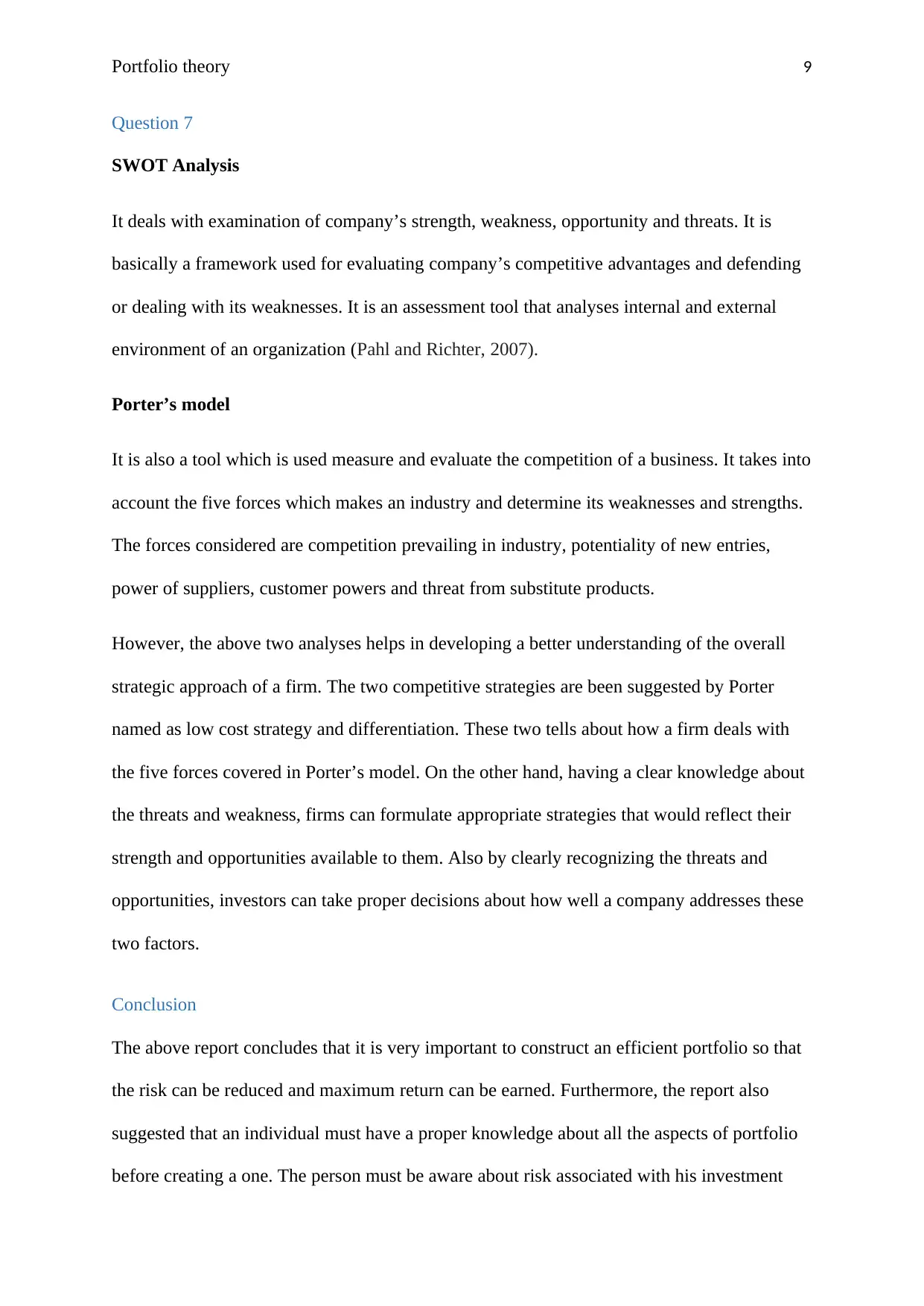
Portfolio theory 9
Question 7
SWOT Analysis
It deals with examination of company’s strength, weakness, opportunity and threats. It is
basically a framework used for evaluating company’s competitive advantages and defending
or dealing with its weaknesses. It is an assessment tool that analyses internal and external
environment of an organization (Pahl and Richter, 2007).
Porter’s model
It is also a tool which is used measure and evaluate the competition of a business. It takes into
account the five forces which makes an industry and determine its weaknesses and strengths.
The forces considered are competition prevailing in industry, potentiality of new entries,
power of suppliers, customer powers and threat from substitute products.
However, the above two analyses helps in developing a better understanding of the overall
strategic approach of a firm. The two competitive strategies are been suggested by Porter
named as low cost strategy and differentiation. These two tells about how a firm deals with
the five forces covered in Porter’s model. On the other hand, having a clear knowledge about
the threats and weakness, firms can formulate appropriate strategies that would reflect their
strength and opportunities available to them. Also by clearly recognizing the threats and
opportunities, investors can take proper decisions about how well a company addresses these
two factors.
Conclusion
The above report concludes that it is very important to construct an efficient portfolio so that
the risk can be reduced and maximum return can be earned. Furthermore, the report also
suggested that an individual must have a proper knowledge about all the aspects of portfolio
before creating a one. The person must be aware about risk associated with his investment
Question 7
SWOT Analysis
It deals with examination of company’s strength, weakness, opportunity and threats. It is
basically a framework used for evaluating company’s competitive advantages and defending
or dealing with its weaknesses. It is an assessment tool that analyses internal and external
environment of an organization (Pahl and Richter, 2007).
Porter’s model
It is also a tool which is used measure and evaluate the competition of a business. It takes into
account the five forces which makes an industry and determine its weaknesses and strengths.
The forces considered are competition prevailing in industry, potentiality of new entries,
power of suppliers, customer powers and threat from substitute products.
However, the above two analyses helps in developing a better understanding of the overall
strategic approach of a firm. The two competitive strategies are been suggested by Porter
named as low cost strategy and differentiation. These two tells about how a firm deals with
the five forces covered in Porter’s model. On the other hand, having a clear knowledge about
the threats and weakness, firms can formulate appropriate strategies that would reflect their
strength and opportunities available to them. Also by clearly recognizing the threats and
opportunities, investors can take proper decisions about how well a company addresses these
two factors.
Conclusion
The above report concludes that it is very important to construct an efficient portfolio so that
the risk can be reduced and maximum return can be earned. Furthermore, the report also
suggested that an individual must have a proper knowledge about all the aspects of portfolio
before creating a one. The person must be aware about risk associated with his investment
Paraphrase This Document
Need a fresh take? Get an instant paraphrase of this document with our AI Paraphraser
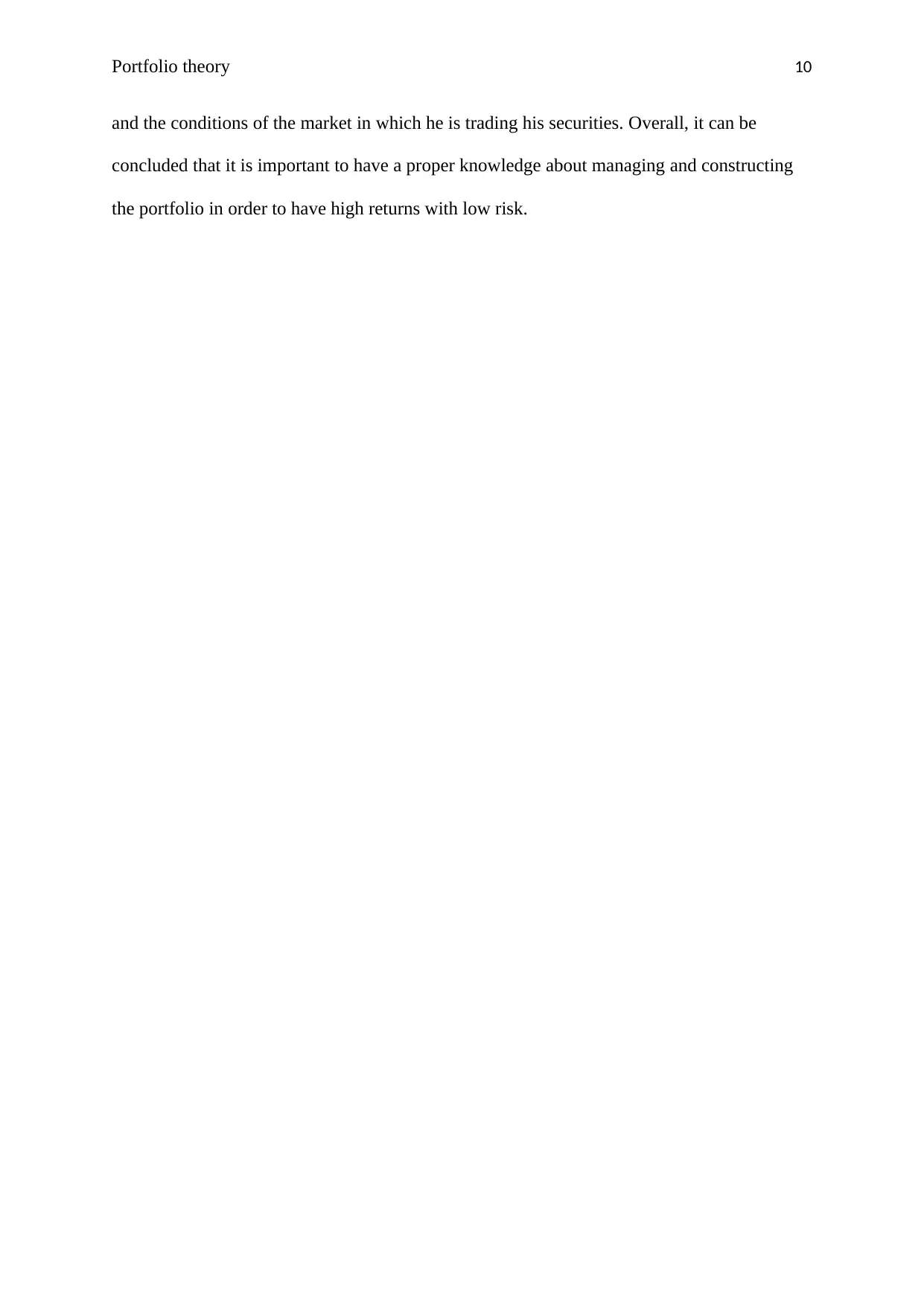
Portfolio theory 10
and the conditions of the market in which he is trading his securities. Overall, it can be
concluded that it is important to have a proper knowledge about managing and constructing
the portfolio in order to have high returns with low risk.
and the conditions of the market in which he is trading his securities. Overall, it can be
concluded that it is important to have a proper knowledge about managing and constructing
the portfolio in order to have high returns with low risk.
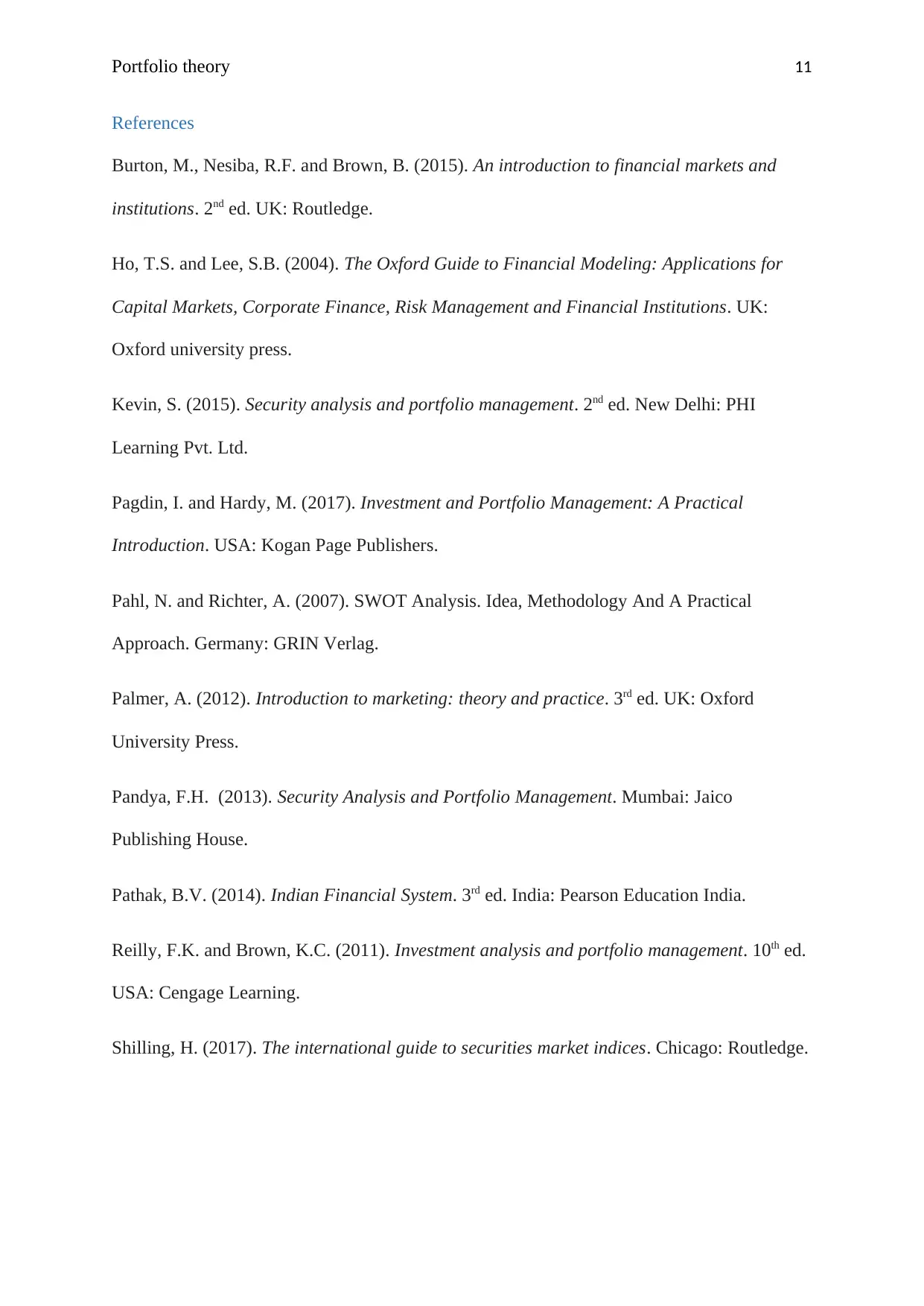
Portfolio theory 11
References
Burton, M., Nesiba, R.F. and Brown, B. (2015). An introduction to financial markets and
institutions. 2nd ed. UK: Routledge.
Ho, T.S. and Lee, S.B. (2004). The Oxford Guide to Financial Modeling: Applications for
Capital Markets, Corporate Finance, Risk Management and Financial Institutions. UK:
Oxford university press.
Kevin, S. (2015). Security analysis and portfolio management. 2nd ed. New Delhi: PHI
Learning Pvt. Ltd.
Pagdin, I. and Hardy, M. (2017). Investment and Portfolio Management: A Practical
Introduction. USA: Kogan Page Publishers.
Pahl, N. and Richter, A. (2007). SWOT Analysis. Idea, Methodology And A Practical
Approach. Germany: GRIN Verlag.
Palmer, A. (2012). Introduction to marketing: theory and practice. 3rd ed. UK: Oxford
University Press.
Pandya, F.H. (2013). Security Analysis and Portfolio Management. Mumbai: Jaico
Publishing House.
Pathak, B.V. (2014). Indian Financial System. 3rd ed. India: Pearson Education India.
Reilly, F.K. and Brown, K.C. (2011). Investment analysis and portfolio management. 10th ed.
USA: Cengage Learning.
Shilling, H. (2017). The international guide to securities market indices. Chicago: Routledge.
References
Burton, M., Nesiba, R.F. and Brown, B. (2015). An introduction to financial markets and
institutions. 2nd ed. UK: Routledge.
Ho, T.S. and Lee, S.B. (2004). The Oxford Guide to Financial Modeling: Applications for
Capital Markets, Corporate Finance, Risk Management and Financial Institutions. UK:
Oxford university press.
Kevin, S. (2015). Security analysis and portfolio management. 2nd ed. New Delhi: PHI
Learning Pvt. Ltd.
Pagdin, I. and Hardy, M. (2017). Investment and Portfolio Management: A Practical
Introduction. USA: Kogan Page Publishers.
Pahl, N. and Richter, A. (2007). SWOT Analysis. Idea, Methodology And A Practical
Approach. Germany: GRIN Verlag.
Palmer, A. (2012). Introduction to marketing: theory and practice. 3rd ed. UK: Oxford
University Press.
Pandya, F.H. (2013). Security Analysis and Portfolio Management. Mumbai: Jaico
Publishing House.
Pathak, B.V. (2014). Indian Financial System. 3rd ed. India: Pearson Education India.
Reilly, F.K. and Brown, K.C. (2011). Investment analysis and portfolio management. 10th ed.
USA: Cengage Learning.
Shilling, H. (2017). The international guide to securities market indices. Chicago: Routledge.
⊘ This is a preview!⊘
Do you want full access?
Subscribe today to unlock all pages.

Trusted by 1+ million students worldwide
1 out of 12
Related Documents
Your All-in-One AI-Powered Toolkit for Academic Success.
+13062052269
info@desklib.com
Available 24*7 on WhatsApp / Email
![[object Object]](/_next/static/media/star-bottom.7253800d.svg)
Unlock your academic potential
Copyright © 2020–2025 A2Z Services. All Rights Reserved. Developed and managed by ZUCOL.





